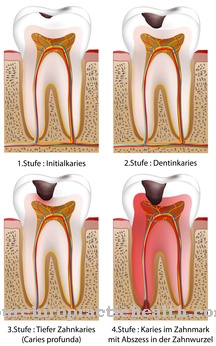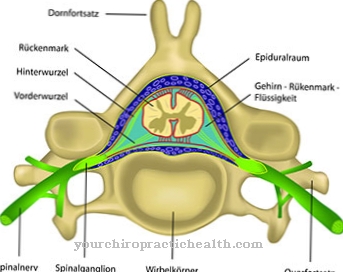At muscular imbalance there is an imbalance between the agonistic and antagonistic muscles involved in a particular movement. This type of imbalance is often caused by a lack of exercise, after trauma or as a result of neurogenic diseases. The therapy of choice is physiotherapy, with training sessions being combined with electrical stimulation under certain circumstances.
What is muscular imbalance?

© Orlando Florin Rosu - stock.adobe.com
To perform movements, humans rely on the interaction of opposing muscles that are connected to the central nervous system via efferent motor innervation. Muscles never work alone in their contraction. The agonist who realizes movement is dependent on an opponent or antagonist who enables movement in the opposite direction. If these are not equally strong, there is a muscular imbalance.
When the agonistic flexor bends, the antagonistic extensor must stretch at the same time. The return to the starting position is made possible by flexing the extensor, which in turn has the original flexor as the antagonist. Abdominal muscles, for example, are the antagonists of the back muscles and vice versa. Agonistic and antagonistic muscles should be roughly the same strength.
If this is not the case, there is a muscular imbalance. Bad posture, pain and irreversible damage can be the long-term consequences of such imbalances. In the context of rehabilitation and physiotherapy exercises, for example, balanced training for agonists and antagonists is the overriding goal. The sometimes most common imbalances affect the abdominal muscles, which are usually much less developed than the antagonistic back muscles.
causes
The cause of a muscular imbalance is essentially muscle shortening or muscle weakening from either an agonist or an antagonist. These phenomena can be based on one-sided development of force, which is accompanied by neglect of the ability to stretch. The most important trigger for this phenomenon is insufficient or complete lack of use of the affected muscle.
However, one-sided stresses in sport and in everyday life are also possible causes. The muscular imbalance can also appear as a symptom of a superordinate disease or as a result of trauma. The associated diseases are usually diseases of the central nervous system, such as the autoimmune disease multiple sclerosis.
If motor nerve tissue is damaged by such diseases, fewer movement commands from the central nervous system reach a muscle. As a result, the affected muscle can no longer be trained or used as much as its antagonist. This phenomenon can also occur in the case of motor nerve damage to the body periphery, for example in the context of neuropathy.
If the muscular imbalance occurs as a result of trauma to the musculoskeletal system, inadequate regeneration or a pain-related improper load is usually the cause.
You can find your medication here
➔ Medicines for muscle weaknessSymptoms, ailments & signs
The symptoms of muscular imbalance are highly dependent on the primary cause. In the case of muscular imbalances due to muscle shortening, a muscle adapts to a specific stimulus through higher tension, while its opponent has not been exposed to any muscle and thus maintains its previous tension. The foreshortening relationship between the two is thus disturbed.
Muscular imbalances due to muscle lengthening, on the other hand, exist when a muscle adapts to a specific stimulus through lower tension. The tension of the other muscle remains constant again, which changes the shortening ratio. If there is an unfavorable load distribution between muscles and joints over the long term, arthro-muscular imbalance with painful muscle tension, tendon overload and muscular coordination or functional disorders arise.
This can result in increased wear and tear on the articular cartilage. In the case of neurogenic imbalance causes in the peripheral nervous system, in addition to the motor function, the sensitivity of the affected area is often limited. The same can be the case with central nervous causes.
Diagnosis & course
A pronounced muscular imbalance can be diagnosed by doctors and, above all, physiotherapists through visual diagnosis. In the anamnesis, previous trauma or known neurogenic diseases can indicate an imbalance. Symptoms such as a hunched back also indicate an imbalance.
Layer images of the muscles, which allow an assessment of the muscle characteristics, are used to confirm the diagnosis. The patient's prognosis depends on the primary cause. Basically, every imbalance can be improved through targeted training. With central nervous causes, however, a generally poorer prospect of full restoration of the muscle relationship is associated than with other causes.
Complications
Muscular imbalances are common. Actually, everyone is at least slightly affected by it, because certain muscles or muscle groups are always less stressed than others. With minor imbalances there are no complaints. Greater muscular imbalances lead to chronic pain.
As a rule, the muscles can be trained evenly with a few exercises, so that the symptoms also disappear again. If nothing is done, however, complications arise over time, which are often characterized by irreversible changes. What complications can arise? The most important complications include muscle tension, tendopathies and arthritis.
Muscle tension develops in the context of prolonged poor posture. They can be painless. Often, however, there is pain on pressure or movement. The muscle tissue hardens. Muscle tension can also be reversed through various therapeutic measures.
Tendopathies are micro-tears in the tendons of strong muscles. Sometimes these cannot heal completely. Therefore it can lead to degenerative changes. The tendon attachments show ossification and calcium deposits. These changes are not primarily inflammatory.
Mechanical irritation can lead to secondary inflammation, which accelerates the degeneration process. Sometimes the only way to relieve the symptoms is surgery. In the worst case, a muscular imbalance can also lead to osteoarthritis with subsequent joint deformation and severe restriction of movement.
When should you go to the doctor?
In many cases this disease is diagnosed relatively late because the symptoms are not particularly characteristic and can be confused with other diseases. In general, the person concerned should therefore consult a doctor if there is discomfort and pain in the muscles for no particular reason. These symptoms can indicate another underlying disease that should be treated.
In any case, a doctor must be consulted if the pain results in restricted mobility, which usually does not go away on its own and persists over a longer period of time. This can also lead to infections and inflammation. To prevent these from spreading any further, treatment should be given by a doctor. It is not uncommon for the permanent pain and restricted mobility to lead to psychological complaints. In this case, treatment by a psychologist should also take place. First and foremost, a general practitioner can be seen to diagnose the disease. In the further course, the treatment must then be carried out by a specialist.
Treatment & Therapy
The therapy of choice for patients with muscular imbalance is physiotherapy. In the case of neurogenic causes, referral to a neurologically trained physiotherapist is indicated. As part of the physiotherapeutic care, antagonists and agonists are trained to the same extent to restore balance.
Especially in diseases of the central nervous system, this goal turns out to be an ambitious goal. If nerve tissue in the spinal cord or brain is damaged, contraction commands no longer adequately reach the muscles, which makes training significantly more difficult. This connection can also interfere with the training units with peripheral nerve diseases. In such cases, physiotherapy can be combined with electrical stimulation.
The direct stimulation stimulates the muscle to contract independently of nerve impulses and trains it accordingly without involving the nerve pathways. During the physiotherapy sessions, particular attention is paid to muscle tremors. As soon as the muscles begin to tremble, a break is taken.
Outlook & forecast
The further course of the imbalance depends to a relatively large extent on the cause of the disease, which is why no universal prediction is possible. However, there is rapid irritation and overloading of the muscles. Muscle tension or functional disorders also occur in the muscles. In severe cases, these can also restrict the patient's movement.
If the imbalance is caused by an accident or trauma, the patients often suffer from psychological complaints and need support from a psychologist. If the muscle imbalance becomes severe, pain sets in. These can restrict the everyday life of the person concerned. However, it is not uncommon for the pain to go away on its own.
If tears in tendons and muscles do not heal properly, malformations and inflammation can occur. These also lead to a restriction of movement.
In most cases, the imbalance is treated in therapy. This depends primarily on the cause of the imbalance. If nerves have been damaged, not all restrictions can be healed.
You can find your medication here
➔ Medicines for muscle weaknessprevention
Muscular imbalances can be prevented in everyday life by performing the correct movement, sufficient movement and even exposure of agonists and antagonists. Since posture also contributes to correct movement management, attending a posture school can be useful. After trauma, the imbalance can be prevented in the form of professionally supervised and as complete regeneration as possible as part of rehabilitation measures.
Aftercare
The therapy of a muscular imbalance can only have a lasting effect if there is consistent follow-up care. The patient can do this well with a physiotherapist or sports teacher for the rehabilitation area, but also in the gym. The aim is basically to compensate for the muscular imbalance or to avoid it in advance by strengthening the weak muscles and stretching shortened muscles.
One example is the stretching of shortened chest muscles and the strengthening of the upper back in people who work on the PC every day in a bent position. Muscles are strengthened with targeted strength training, for which the patient can have an individual plan drawn up by the physiotherapist or rehabilitation sports teacher. In the context of aftercare, it is also important to design this training efficiently with correct exercise execution and regular units as well as the individually optimal load dosage.
Stretching shortened muscles is just as important in muscular imbalance as strengthening them. Stretching isn't just an important element before and after exercise.It can also be effectively incorporated into aftercare in everyday life, for example during work breaks.
Special stretching classes are also often helpful, as is yoga, which is ideal for whole-body strengthening and does not neglect stretching muscles. Anyone who tends to shorten certain muscles should also pay attention to an ergonomic design of the workplace.
You can do that yourself
Correct sitting is essential to counteract muscular imbalances. It is recommended to sit ergonomically and dynamically on the office chair. A combination with a height-adjustable desk makes sense. The sitting position should be changed as often as possible, and working while standing and actively walking around is recommended in everyday office life.
Muscular imbalances often result from a lack of exercise. It is therefore important to integrate more exercise into everyday life. It makes sense to cycle to work or to park a bit away to walk for a few more minutes. Instead of the elevator, it is better to use the stairs and the printer should not be directly at the workplace to get up from time to time.
Since muscular imbalances can be caused by one-sided training and a lack of stretching during sport, care should be taken to always warm up and also to train opponents at all times. It is also important to wear suitable footwear. When doing sports, you should avoid inconsiderate increases in load, falls, running on uneven surfaces and excessive muscular strain. In this way, muscular imbalances can also be avoided.
Sports in which many muscle groups are balanced and stressed at the same time, such as dancing, gymnastics or martial arts, help with muscular imbalances. A varied training program with strengthening, coordination, balance and stretching exercises is also useful. If improvements do not come about through self-help measures, sports therapy is advisable; deficits in the muscles are remedied through targeted exercises under guidance.

.jpg)
.jpg)
.jpg)


.jpg)


















.jpg)


